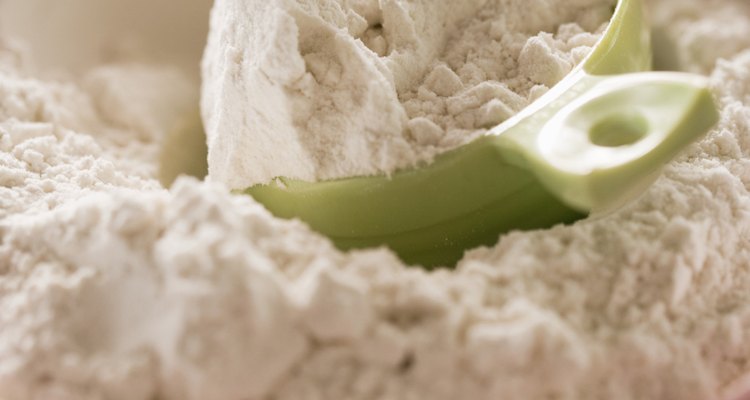
Despite its place on many ingredients labels and recipe lists, enriched flour continues to generate controversy in the nutrition and culinary worlds. Enriched flour, which goes hand-in-hand with bleached flour, is a type of flour from which the natural vitamins and minerals have been removed in an effort to create a finer texture and increased shelf life. Flour manufacturers then add nutrients back into the flour to “enrich” the product. These processes involve potentially harmful chemicals and may introduce health risks.
Added Nutrients
Typically, enriched flour manufacturers add helpful nutrients back into the nutrient-stripped flour, including the B vitamins niacin, riboflavin, thiamin mononitrate and folic acid. On average, about 11 vitamins and minerals are removed from enriched flour, with only about five added back. These additions do not typically match the nutritional content of whole wheat flour; a 2009 study published in the International Journal of Food Sciences and Nutrition reported that enriched flours featured poor homogenization of folic acid and iron.
More Chemcials
Most enriched white flours contain bleached flour, unless the package specifically lists “unbleached,” “whole wheat,” or “whole grain” flour. Bleached flour -- which aims to increase shelf life and create lighter, fluffier breads and baked goods -- is subject to chemical bleaching agents including chlorine, bromate and peroxide. Bleaching may also result in the formation of the chemical alloxan, a toxin that increases the risk of diabetes.
Possible Dangers
Because enriched flour does not contain the nutrient- and fiber-rich bran and germ, your body breaks it down more quickly than whole wheat flour, which may raise your blood sugar and, in turn, cause weight gain. While chlorine bleaching agents may increase the risk of diabetes, bromate has been linked to cancer, causing a ban on the chemical in most countries, excluding the U.S. and Japan.
Alternatives
Whole wheat or whole grain flour, which keeps the bran and germ intact, serves as an accessible alternative to enriched flour. In addition to the health benefits, some chefs claim that whole wheat flour heightens the flavor of baked goods and other dishes. Likewise, this common alternative packs more fiber, protein, calcium and minerals than its enriched counterpart. Non-wheat coconut flour, chickpea flour and quinoa flour also serve as healthy, gluten-free -- and typically chemical-free -- alternatives to enriched flour, though each affects recipes slightly differently in terms of taste and texture.
Related Articles
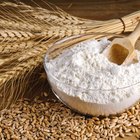
Differences Between Bleached Flour & ...
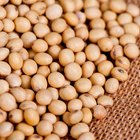
Is Soy Flour Healthy?

Does Cake Flour Contain Baking Soda & ...
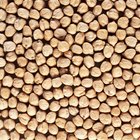
How to Roast Chickpea Flour

What Additives Are in Flour?

How Does Brewer's Yeast Benefit Skin?

Can You Substitute Whole Wheat Pastry ...

Substitute for Gram or Besan Flour

How to Replace Flour With Oat Flour

Psyllium Husk & Gluten

What Is the Nutritional Value of Wheat?

Difference Between Canned Pumpkin & ...
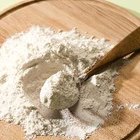
Does it Help to Keep Flour in the ...

Bread Flour vs. Cake Flour in Sponge ...

Whole Wheat Pastry: Flour Substitutions

How to Make Pumpernickel Flour
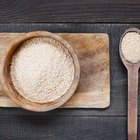
Substitutes for Oat Bran

Can I Grind Quinoa?
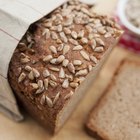
Russian Rye Bread vs. Pumpernickel

What Is Amaranth Flour?
References
- A Healthier Michigan: What's In Your Foot? Enriched Flour Tops List of Unhealthy Ingredients
- LabelWatch.com: All-Purpose Flour
- LabelWatch.com: Bleached Wheat Flour
- YouTube: Enriched Wheat Flour (Killer Flour), Andrew L. Siegel, M.D.
- PubMed.gov: International Journal of Food Science Nutrition: Physico-Chemical Quality and Homogeneity of Folic Acid and Iron in Enriched Flour Using Principal Component Analysis
- Mercola.com: The Little-Known Secrets About Bleached Flour...
Writer Bio
With a diverse professional background and a decade of experience as a freelance writer, Dan has contributed lifestyle content -- from fashion to travel to fitness and more -- to publishers including Chron, Fortune, Sony, GlobalPost, ModernMom, Moviefone, Salon.com, Techwalla and dozens of others.
Photo Credits
Jupiterimages/Goodshoot/Getty Images